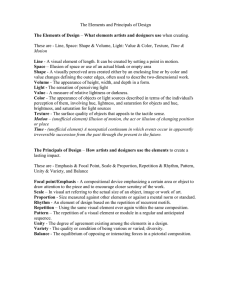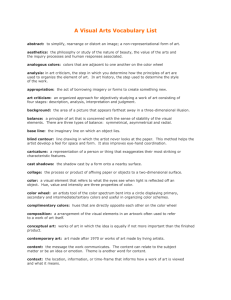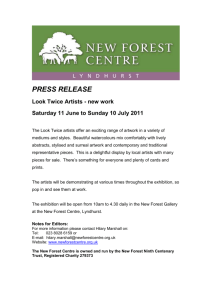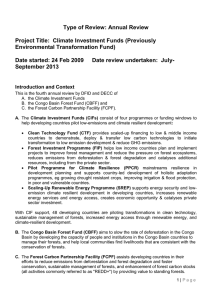Visual Art - ode.state.or.us
advertisement
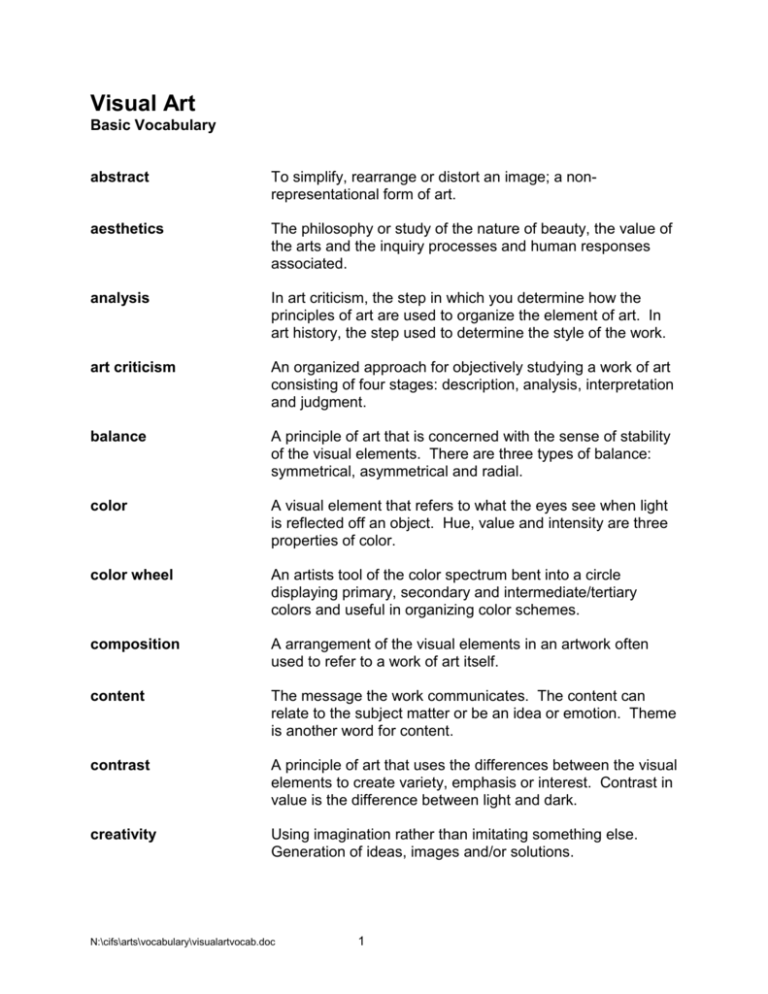
Visual Art Basic Vocabulary abstract To simplify, rearrange or distort an image; a nonrepresentational form of art. aesthetics The philosophy or study of the nature of beauty, the value of the arts and the inquiry processes and human responses associated. analysis In art criticism, the step in which you determine how the principles of art are used to organize the element of art. In art history, the step used to determine the style of the work. art criticism An organized approach for objectively studying a work of art consisting of four stages: description, analysis, interpretation and judgment. balance A principle of art that is concerned with the sense of stability of the visual elements. There are three types of balance: symmetrical, asymmetrical and radial. color A visual element that refers to what the eyes see when light is reflected off an object. Hue, value and intensity are three properties of color. color wheel An artists tool of the color spectrum bent into a circle displaying primary, secondary and intermediate/tertiary colors and useful in organizing color schemes. composition A arrangement of the visual elements in an artwork often used to refer to a work of art itself. content The message the work communicates. The content can relate to the subject matter or be an idea or emotion. Theme is another word for content. contrast A principle of art that uses the differences between the visual elements to create variety, emphasis or interest. Contrast in value is the difference between light and dark. creativity Using imagination rather than imitating something else. Generation of ideas, images and/or solutions. N:\cifs\arts\vocabulary\visualartvocab.doc 1 emphasis A principle of art that stresses one element of art, defines a center of interest or draws attention to certain areas with a work of art. form The visual element that is three-dimensional; having height, width and depth. harmony The related qualities of the visual elements of a composition. Harmony is achieved by repetition of characteristics that are the same or similar. line A visual element that is the path of a moving point through space. It has the properties of direction, width and length. medium (media) The materials used to create a work of art. movement A principle of art used to guide a viewer’s eye throughout the work; a trend. negative space Spaces surrounding shapes or forms in two- and threedimensional art. pattern Repetition of elements or motif. perspective A formula for projecting the illusion of three-dimensional space onto a two-dimensional surface. positive space Shapes or forms in two-dimensional and three-dimensional art. principles of design Refers to the ways artists organize the visual elements of art: generally found to include balance, emphasis, contrast, unity, movement and rhythm. May also include: proportion, scale, repetition, pattern, and variety. proportion A principle of art concerned with the relationships in size, one part to another or to the whole. repetition An art element repeated over and over that can produce visual rhythm. rhythm A principle of art in which the appearance of movement is created by the recurrence of elements. scale When proportional relationships are created relative to a specific unit of measurement. N:\cifs\arts\vocabulary\visualartvocab.doc 2 shape The visual element that has two-dimensions: height and width. A space with a defined or implied boundary. Two basic groups: geometric and organic. space The visual element that refers to the area between, around, above, below and within objects. style The identifying characteristics of the artwork of an individual, a group of artists, a period of time or an entire society. symbol A visual image that represents something other than itself. technique Specific methods or approaches when working with materials in creating works of art. texture The visual element that refers to the way something feels or looks like it feels and can be actual or implied. unity A principle of art that is concerned with the sense of wholeness or completeness. value The visual element that refers to lightness and darkness. variety A principle of art through which different elements are used to add visual interest. visual elements of design . The basic ingredients artists use to create works of art: line, shape, form, color, texture and space. N:\cifs\arts\vocabulary\visualartvocab.doc 3
